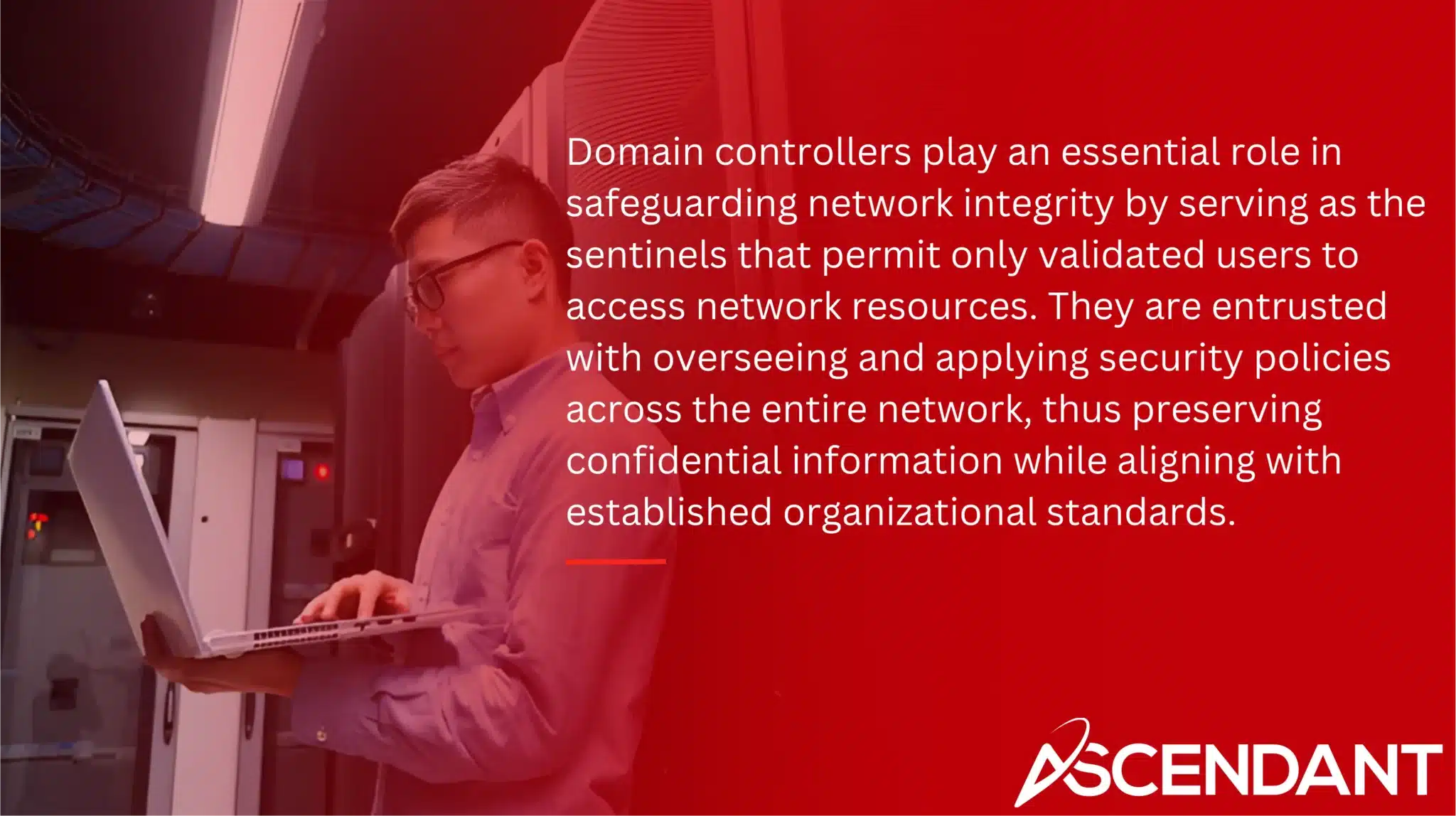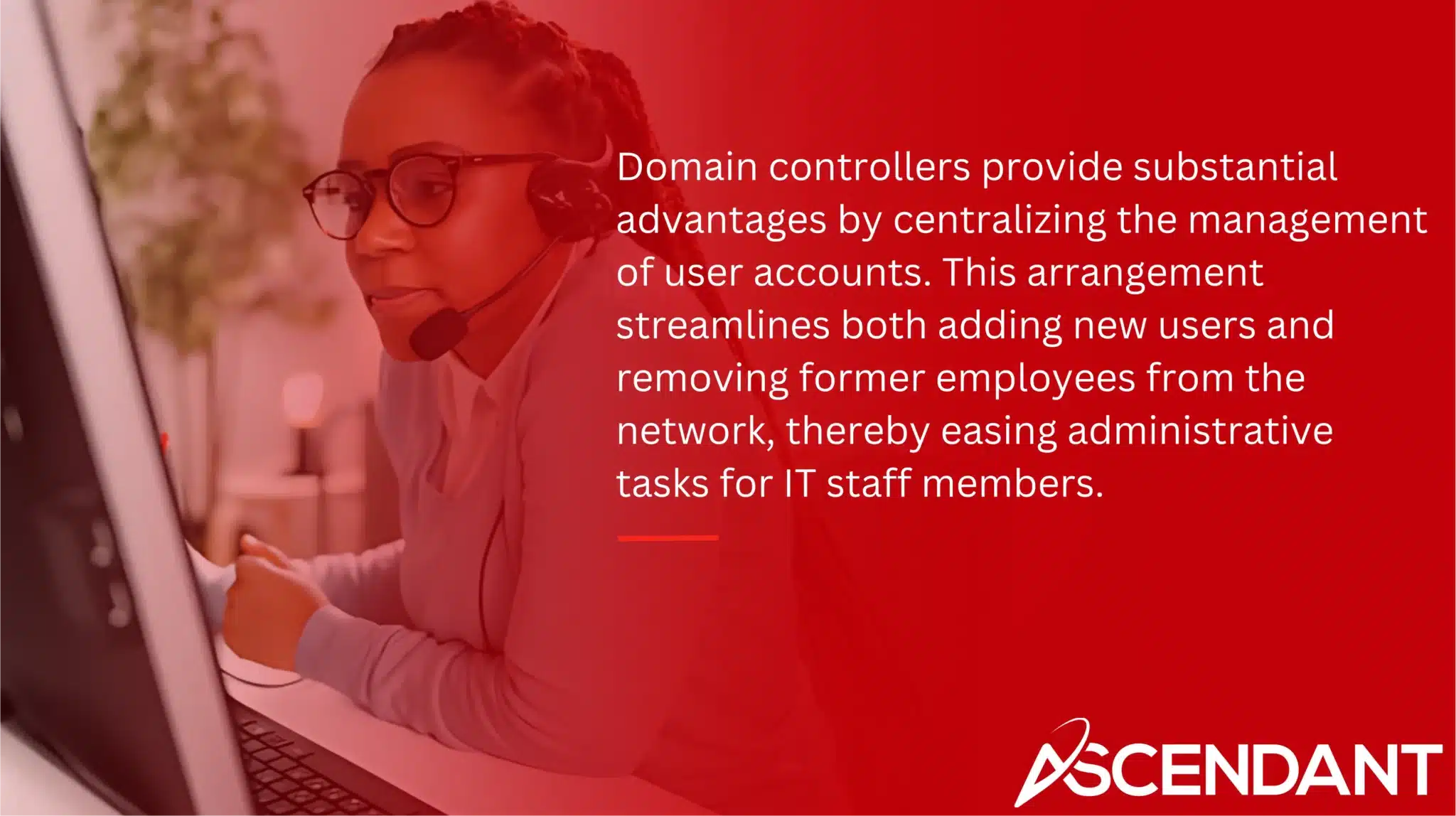Wondering what a domain controller is and why it’s essential for network security? A domain controller is a server that verifies user credentials and controls access to network resources in a Windows environment. This article explores its key functions, importance, setup process, types, and how to enhance its security.
In This Article:
- What is a Domain Controller?
- Key Functions of a Domain Controller
- Importance of Domain Controllers in Network Security
- Setting Up an Active Directory Domain Controller
- Types of Domain Controllers
- Enhancing Security for Domain Controllers
- Benefits of Using Domain Controllers
- Limitations and Challenges of Domain Controllers
- Modern Alternatives to Traditional Domain Controllers
- Best Practices for Managing Domain Controllers
Key Takeaways
- Domain controllers serve as central servers for user authentication and authorization, critical for managing access and maintaining security in a network.
- They enable centralized management of user accounts and policies, ensuring consistent security standards while facilitating efficient resource management.
- Securing domain controllers is essential due to their importance; regular updates, multi-factor authentication, and incident recovery plans are pivotal to preventing unauthorized access and ensuring network integrity.
What is a Domain Controller?
A domain controller serves as the pivotal server that ensures network and identity safety, acting as a crucial checkpoint for user access authentication and authorization. Its primary role is to confirm the validity of Windows user accounts, allowing only those with proper clearance to utilize network resources. Their essential position in managing permissions within an Active Directory environment highlights their importance.
These controllers are tasked with structuring and safeguarding information pertaining to group policies and user accessibility while upholding security protocols across Windows networks. When users seek entry via login, it is the responsibility of these controllers to verify identities through authentication requests before allocating suitable access rights based on established guidelines.
Extending its scope beyond mere authentication duties, domain controllers also house active directory services which serve as vital tools for centralized management of user accounts along with policy application enforcement—a process that efficiently fortifies control over network resource allocation.
Key Functions of a Domain Controller
Domain controllers are pivotal in ensuring the seamless functionality of a network. Their chief role is to authenticate user identities against information held within Active Directory, confirming that only authorized individuals can access network resources and upholding security and integrity.
These domain controllers oversee the regulation of access to an array of network resources by enforcing specific security policies and permissions. They utilize group policies as mechanisms for implementing prescribed rules and procedures across varying groups of users within the organization, thus assuring uniformity in security protocols throughout the domain.
Domain controllers maintain critical data within the Active Directory Domain Services database. This repository is key to administering both user access rights and application accessibility. Consequently, domain controllers serve an indispensable purpose in guaranteeing secure governance over network resource utilization.
Importance of Domain Controllers in Network Security

Domain controllers play an essential role in safeguarding network integrity by serving as the sentinels that permit only validated users to access network resources. They are entrusted with overseeing and applying security policies across the entire network, thus preserving confidential information while aligning with established organizational standards.
In their commitment to shield unauthorized entry into the domain, domain controllers manage access meticulously through secure user authentication protocols. They bolster defense mechanisms by keeping a vigilant eye on who is accessing what data within the system – a measure crucial for early detection and thwarting of illegitimate access attempts.
As these pivotal elements in controlling network access stand at the forefront of cyber threat exposure, ensuring their robust security is indispensable for defending against possible intrusions that can compromise customer data along with other classified assets — making them instrumental in reinforcing overall network protection.
Setting Up an Active Directory Domain Controller
Initiating the process of establishing an Active Directory Domain Controller necessitates installing Windows Server. Following the successful launch of the server, administrators must proceed with setting up Active Directory Domain Services (AD DS). This configuration is streamlined through a wizard provided by ADDS, which aids in promoting the new server to function as a domain controller.
It’s imperative during setup to create an exclusive password for accessing Directory Services Restore Mode (DSRM), a vital component for conducting recovery operations when faced with system breakdowns or serious issues. Options are available for those configuring the domain controller to concurrently serve as both DNS and Global Catalog servers, thereby amplifying its capabilities and its integration within the overarching network.
Once installation and settings adjustments are complete, it’s critical to confirm that all aspects of your newly configured domain controller are functioning optimally. Diagnosing health can be achieved via specific diagnostic commands designed to check if services have commenced properly and validate that your domain controller is primed for operation—these measures ensure you lay down solid groundwork essential for maintaining a stable and secure active directory framework.
Types of Domain Controllers
Various types of domain controllers exist within a network, fulfilling distinct roles. The primary domain controller (PDC) handles the main tasks related to user authentication and is pivotal for synchronizing directory updates. It manages the processing of authentication requests and maintains the central Active Directory database to secure all user sign-ins.
Supporting the PDC are backup domain controllers (BDC), which safeguard a duplicate set of user credentials so that they can step in seamlessly if there’s ever an issue with the PDC. This layer ensures that security and network service remain uninterrupted.
Virtual Domain Controllers offer another aspect, running within virtual machines, thus providing adaptability and potential growth for managing networks. These diverse domain controller options enable establishments to customize their infrastructure according to their specific requirements, whether dealing with one or multiple domains hosted on separate servers throughout their network.
Enhancing Security for Domain Controllers
Securing domain controllers is paramount due to their vital role. To mitigate vulnerabilities and guard against security threats, it’s essential to frequently update them with the latest security patches. Employing physical safeguards like secured enclosures and BitLocker Drive Encryption is imperative for thwarting unauthorized direct access to these controllers.
Incorporating multi-factor authentication (MFA) is a key strategy for ensuring that only verified users gain entry to the domain controllers. Segregating these critical assets from other sections of the network through network segmentation can considerably diminish potential risks associated with lateral attacks within the network.
The development of thorough incident recovery strategies is indispensable in resuming normal operations after a security incident occurs. Continual oversight and regulation of security policies are necessary practices as well as utilizing intrusion detection systems which serve as robust mechanisms in identifying unusual behavior and bolstering protective measures surrounding domain controllers.
Benefits of Using Domain Controllers

Domain controllers provide substantial advantages by centralizing the management of user accounts. This arrangement streamlines both adding new users and removing former employees from the network, thereby easing administrative tasks for IT staff members. It also allows for simultaneous updates or software rollouts to various groups within an organization, which is a significant time-saver.
As users join the domain’s network, domain controllers are equipped to auto-configure connected devices like printers automatically. This feature minimizes manual configuration efforts and helps ensure that all peripherals adhere to correct settings without additional oversight. Integration with third-party applications Improves the efficiency of managing user account information through domain controllers.
In light of technological advancements in directory services, many businesses are transitioning towards cloud-based options such as Azure Active Directory. These contemporary cloud directory services offer enhanced scalability and adaptability benefits that enable organizations to grow their infrastructure seamlessly compared to conventional on-premise domain controller frameworks.
Limitations and Challenges of Domain Controllers
While domain controllers offer numerous advantages, they are not without their drawbacks and difficulties. A primary concern is their reliance on continuous operation. Should a domain controller experience downtime, the entire network’s operations could be impacted. These controllers are perpetually vulnerable to emergent Windows security flaws that may jeopardize the integrity of network protection.
The upkeep of domain controllers necessitates extra hardware provisions and expert knowledge, which translates into increased costs for businesses. By default, these systems do not inherently support features for high availability or adhere to best practices for security measures—complications which render secure connections between remote users and local area networks more problematic.
Such obstacles underscore the importance of implementing stringent management protocols and ongoing vigilance in order to maintain both the safety and efficiency of domain controllers within a given network environment.
Modern Alternatives to Traditional Domain Controllers
Contemporary IT landscapes are increasingly adopting cloud directory services as a contemporary alternative to conventional domain controllers. These cloud-based systems negate the necessity for local on-site infrastructure, which in turn reduces expenses and streamlines the implementation process. They deliver versatile deployment choices, encompassing physical servers, virtual environments or within a mixed IT framework.
These innovative cloud directory services facilitate the incorporation of existing on-premises assets with an array of cloud solutions, granting uninterrupted access to various IT resources without regard to their platform, protocol vendor or geographic location. They come equipped with enhanced features like attribute-driven access control and compatibility with human resource platforms for managing user lifecycles.
Employing these up-to-date substitutes empowers organizations by providing sophisticated instruments designed to administer user identities and permissions more effectively compared to the limitations imposed by traditional setups involving domain controllers.
Best Practices for Managing Domain Controllers
Administering domain controllers effectively requires adherence to certain key practices. It is essential to guarantee redundancy and availability by having a primary domain controller along with at least one backup counterpart. To ward off unauthorized access, physical security protocols like placing the controllers in secure racks or dedicated rooms are vital.
The implementation of a least-privilege approach for administrative accounts is beneficial. It confines their privileges strictly to what’s necessary for their roles, diminishing potential abuse risks. Routine security checks should also be conducted within the Active Directory framework to detect and promptly address any vulnerabilities.
In preparing for disaster recovery scenarios, evaluating factors such as the type of domain, locations of controllers, and compatibility with current systems ensures operational resilience during disruptions. Adhering to these recommended guidelines helps safeguard both the integrity and performance of your domain controllers.
Summary
Domain controllers serve as the cornerstone of contemporary IT frameworks, playing a vital role in the secure and streamlined management of both user identities and various network resources. Their importance extends from their core operations and configuration procedures to their advantages and potential obstacles, all of which are critical components for organizations focused on preserving stringent network security.
Adhering to industry best practices while exploring up-to-date alternatives empowers enterprises to enhance their utilization of domain controllers. By doing so, they assure that their network infrastructures remain secure, highly efficient, and flexible enough to adapt to evolving requirements. Implementing such measures will fortify your organization’s technological landscape—laying down a resilient infrastructure capable of supporting ongoing organizational expansion.
 Frequently Asked Questions
Frequently Asked Questions
What is a domain controller?
A domain controller is a server that manages user authentication and authorization in an Active Directory domain, ensuring network and identity security.
Its role is crucial for maintaining a secure and organized network environment.
What are the key functions of a domain controller?
The key functions of a domain controller are user authentication, management of access to network resources, enforcement of security policies, and storage of the Active Directory Domain Services database.
These functions are crucial for maintaining a secure and organized network environment.
Why are domain controllers important for network security?
Domain controllers are vital for network security as they validate user access, manage security policies, and monitor data access, thereby preventing unauthorized access and aiding in the detection of potential security breaches.
What are the types of domain controllers?
In a network environment, there are three main types of domain controllers that serve different purposes: Primary Domain Controllers (PDC), Backup Domain Controllers (BDC), and Virtual Domain Controllers.
What are the modern alternatives to traditional domain controllers?
Modern cloud directory services offer an updated substitute for conventional domain controllers. They deliver improved cost-effectiveness, simplified setup procedures, and advanced functionalities like attribute-based access control within a domain’s directory services.

